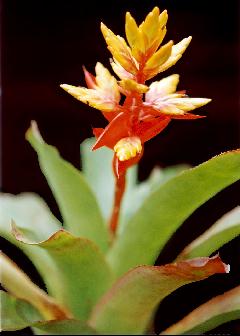
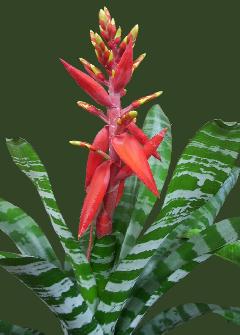

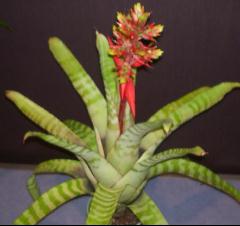
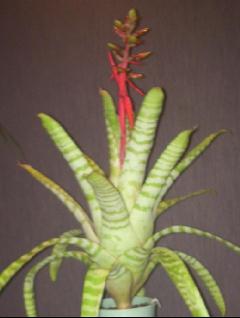
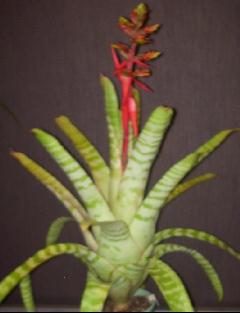
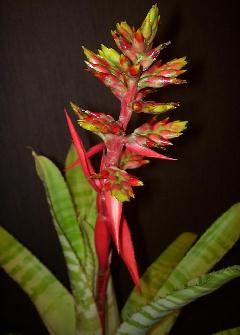
1. Leaves concolorous => forma amazonica
1. Leaves conspicuously silver banded
- 2. Flowers to 30mm long => forma chantinii
- 2. Flowers to 40mm long => variety fuchii
The problem is that rarely do you see the names of amazonica and fuchsii on labels.
My other query relates to the paucity of cultivar names amongst plants similar to A. chantinii. I refer to what are called the Ecuadorian Platyaechmea which is a separate "Uncle Derek Says" article. So if you don't know the difference between say, A. chantinii and A. zebrina or A. tessmannii I suggest you refer to this other article.
The cynic in me says that Aechmea chantinii sells well but sells more if different cultivar names are used. Under the new ICNCP rules the cultivar name should be distinct and able to "stand alone" but with Aechmea chantinii I am not so sure. We only have a selection of photographs to show you but we'll give a list of cultivar names known. We are aware that, in line with all other registered cultivar names there are many more un-registered ones! We have a few of these too!
Anyway here goes.
'Amazonense' BCR pg 1
'Amazonica' BCR pg 1 NOT the official forma amazonica ! THE important part of this problem is that this plant was known as 'Amazonia' (note spelling) in BSIJ 1979 pg192. Surely this is a case of Michael's Bromeliads catalogue being corrected to save further misidentification. Or dare I suggest it be called just Aechmea chantinii.
'Ash Blond' BCR pg 2 Batch of seedlings (not a cultivar) selected by Lee Moore and Holmes
'Black' BCR pg 4
'Black Goddess'
'Black Ice'
'Checkmate' BCR pg 8 Photo JBS;1981 pg 176
'Dark Goddess' BCR pg 10
'Dwarf' BCR pg 11
'Early Bird'
'El Dorado' BCR pg 11
'Frosty' BCR pg 14
'Green Ice'
'Grey Ghost' BCR pg 16 Giant size
'Harlequin' BCR pg 17
'Hazel Quilhot' BCR pg 17 From 'Pink Goddess x 'Nigre'
'John Winston' BCR pg 19 F3 !
'Mako Santan' BCR pg 21
'Midnight Special'
'Mooreana' BCR pg 24 Contrary to the information under this heading this was the plant used by Harry Luther to describe Aechmea moorei! Refer to BSIJ 1980 pg176
'Nigre' BCR pg 24 The reference in JBS 1989 p216 is for an A. nudicaulis hybrid!
'Noir' BCR pg 24
'Norway' BCR pg 25
'Olive's Delight'
'Perumazon' BCR pg 27 cv of forma amazonica
'Pink Banners' BCR pg 27 cv of var fuchsii
'Pink Goddess' BCR pg 28
'Red Goddess' BCR pg 30 Photo JBS 1962 p110
'Samurai' BCR pg 32 From Japanese tissue culture. Yellow striped variegation. Note photograph. What do you call one without variegation?
'Shogun' BCR pg 33 From Japanese tissue culture. Yellow margins
'Silver Goddess' BCR pg 33
'Ski Track' BCR pg 34
'Snow Flake' BCR pg 34
'Solid Green' BCR pg 34 = forma amazonica
'Solid Silver' BCR pg 34
'Stripes on Stripes' BCR pg 35
'Sweden' BCR pg 35 Said to have blue flowers!!!
'Very Black' BCR pg 36
'Vista' BCR pg 37 Variegated
If you have photographs of any of the missing ones or disagree please let us know.
The following synopsis of the subspecific taxa of Aechmea chantinii is presented prior to the publication of a full monograph of the Amazonian taxa of Aechmea subgenus Platyaechmea (Luther, in prep.). A full citation of specimens examined will be given at that time.
Key to the Subspecific Taxa of Aechmea chantinii
1a Leaves concolorous => var. chantinii f. amazonica.
1b Leaves conspicuously silver banded. => 2
2a Flowers to 30 mm long => var. chantinii f. chantinii.
2. Flowers to 40 mm long => var. fuchsii.
Aechmea chantinii var. chantinii forma chantinii
Desc from S&D
Plant to 1 m high.
Leaves 4-10 dm long, densely punctulate-lepidote;
Sheaths large, broadly ovate, castaneous;
Blades ligulate, acute or rounded and apiculate, 6-9 cm wide, typically white-banded beneath.
Scape erect, slender, white-flocculose;
Scape bracts lanceolate, acuminate, laxly serrulate, bright red, the lower lax and erect, the upper spreading and dense.
Inflorescence laxly bipinnate;
Primary bracts lower ones like the scape-bracts, 6-12 cm long, exceeding the spikes, serrulate, the upper abruptly reduced, resembling the floral bracts;
Spikes long-stipitate, narrowly lanceolate, densely 12 flowered; rhachis geniculate, excavated next the flowers.
Floral bracts distichous, broadly ovate, subtruncate, 10-13 mm long, slightly exceeding the ovary, strongly nerved, lepidote;
Flowers to 32 mm long (to 30 mm !Luther).
Sepals asymmetric, 10-12 mm long, equally short-connate, muticous;
Petals obtuse, 2 cm long, orange;
Ovary glabrous; placentae apical; ovules long-caudate.
TYPE: Brazil?, flowered in cultivation, Baraquin in Paris Hortus s.n. (P?), n.v.
DISTRIBUTION. Venezuela, Brazil, Peru.
Aechmea chantinii var. chantinii forma amazonica (Ule) Luther, comb. et stat. nov., Selbyana 10: 56-9. 1987
Aechmea amazonica Ule, Verh. Bot. Ver. Brand. 48: 136. 1907.
Leaves concolorous
TYPE: Ule 6315 (B, F photo 11305) Peru, San Martin, Tarapoto,.
DISTRIBUTION. Colombia, Brazil, Ecuador (?), Peru.
Aechmea chantinii (Carr.) Bak. var. fuchsii Luther, var. nov. Selbyana 10: 56-9. 1987
A typo Aechmeae chantinii var. chantinii similis sed bracteis partibus florum permajoribus.
TYPE. F. Fuchs, Jr. s.n. (SEL, holotype; US, isotype). Ecuador, Napo, without specific locality,
Plant propagating by stout, 30 cm long stolons;
Leaves to 65 cm long, conspicuously silver banded on both sides;
Sheaths elliptic, to 17 cm wide, dark castaneous within,
Blades to 10 cm wide, armed with dark 4 mm long antrorse spines,
Scape erect to decurved, stout, white flocculose;
Scape bracts imbricate but the upper often reflexed, to 18 cm long, serrate, pink.
Primary bracts like the scape bracts but the upper bracts abruptly much reduced. Branches stipitate, spreading, to 12 cm long, 8- to 15-flowered.
Floral bracts broadly ovate, to 2 cm long, yellow green.
Sepals very asymmetrical, 17-20 mm long, yellow green.
Petals 25 mm long, each with 2 basal appendages, bright yellow with white apex.
Ovary to 15 mm long.
DISTRIBUTION. Ecuador.
RELATIONSHIPS. According to overall morphology this new variety fits comfortably within the taxon Aechmea chantinii but differs in the size of the bracts and flower parts being more or less 50 percent larger. This is the first and only verified collection of this species to be found in Ecuador and has been in cultivation for several years under the cultivar name 'Pink Banners'.
Note. See also Lecoufle, Marcel. Les Aechmea Ruiz et Pavon in Jardins de France 138: 99. 1965.
Quote: "We imported numerous plants of this species in several varieties, some different to each other by the aspect of their flowers or their foliage:
A. chantinii. - Green leaves marbled transversely with large white bands. Relatively dwarf plant.
A. chantinii virescens. - Completely green leaves. Now var. amazonica
A. c. grey ghost. - Similar aspect to chantinii but reaching 80 centimeters. Now 'Grey Ghost'
A. c. rubra. - Leaves colour of wine dregs, marbled transversely with silvery white. Not now used
A. c. goddess. - Five times bigger than the variety chantinii of M. Chantin. Pink bracts. Now query 'Pink Goddess'
We propagate these natural varieties and I can affirm that Aechmea chantinii will become a very commercial plant."
From S&D 1979
117. Aechmea chantinii (Carriere) Baker, Handb. Bromel. 49. 1889. Fig 646 F-G. (Schultes & Cabrera 16114)
Billbergia chantinii Carriere, Rev. Hortic. 50: 112, fig. 22. 1878; 52: 2272, figs. 54-56. 1880.
Aechmea amazonica Ule, Verh. Bot. Ver. Brand. 48: 136. 1907. Type. Tarapoto, San Martin, Peru, Ule 6315 (B, photo F 11305), Sep 1902.
Plant to 1 m high.
Leaves 4-10 dm long, densely punctulate-lepidote;
sheaths large, broadly ovate, castaneous;
blades ligulate, acute or rounded and apiculate, 6-9 cm wide, typically white-banded beneath.
Scape erect, slender, white-flocculose;
scape-bracts lanceolate, acuminate, laxly serrulate, bright red, the lower lax and erect, the upper spreading and dense.
Inflorescence laxly bipinnate; lower primary bracts like the scape-bracts, 6-12 cm long, exceeding the spikes, serrulate, the upper abruptly reduced, resembling the floral bracts;
spikes long-stipitate, narrowly lanceolate, densely 12-flowered;
rhachis geniculate, excavated next the flowers.
Floral bracts distichous, broadly ovate, subtruncate, 10-13 mm long, slightly exceeding the ovary, strongly nerved, lepidote;
flowers to 32 mm long.
Sepals asymmetric, 10-12 mm long, equally short-connate, muticous;
petals obtuse, 2 cm long, orange;
ovary glabrous; placentae apical; ovules long-caudate.
Type. Baraquin in Paris Hortus s n (holotype, P if preserved, n v), cultivated. Cultivated Dec 1953 , Foster s n (US, possible clonotype).
Distribution. Epiphytic in forest, 100-1160 m alt, Colombia to Peru and Amazonian Brazil.
COLOMBIA. Vaupes-Amazonas: Soratama, Rio Apaporis, 14 Feb 1952, Schultes & Cabrera 16114 (COL, US). Caqueta: San Luis, Rio Orteguaza, 6 Jan 1969, Cuatrecasas, Soderstrom & Soria 27166 (US). Amazonas: El Encanto to mouth of Rio Carapani, May 1942, Schultes 3822 (GH); Trapecio Amazonico, Oct 1945, Schultes 6599 (US); 6893 (US); Puerto Narino, 2 Jan 1972, C. E. Smith, Jr. 5052 (US). VENEZUELA. Amazonas: Rio Casiquiare, 1969, Farinas, Velasquez & Medina 683 (US, VEN). ECUADOR. Napo: Mera, 30 Dec 1958, Harling 3797 (S, US). PERU. San Martin: Tarapoto, Dec 1929, L. Williams 5913 (F); 6124 (F). Loreto: Caballo-Cocha on Amazon River, 1929, L. Williams 2220 (F); Iquitos, 1929, Klug 349 (F, US); 5 Nov 1940, Asplund 14341 (S, US); 20 Nov 1945, Pires & Black 882 (IAN, GH). BRAZIL. Amazonas: Lago de Badajos, 10 Sep 1950, Froes 26588 (IAN, US); Ilha das Flores, Rio Negro, 21 Feb 1959, Cavalcante 671 (MG, US). Acre: Cruzeiro do Sul, Rio Jurua, 27 Oct 1966, Prance et al 2920 (NY).
Note. For varieties not assessed here cf. Lecoufle, Marcel. Les Aechmea Ruiz et Pavon in Jardins de France 138: 99. 1965.
From Mez 1935
50. Ae. Chantinii (Carr.) Bak. Bromel (1889) 49.
Billbergia Chantini Carr. in Rev. Hortic. L. (1878) 112, fig.22 et LII. (1880) 272, fig. 54-56.
Folia ad 10 ex erccto sub-patentia, late linearia, apice late rotundata impositeque mucronata, margine horride spinosa, pedalii, ad 50 mm lata, utrinque zonis niveis saturateque viridibus transversalibus quam maxime insignia. Vaginae scapales superiores spinoso-serratae. Inflorescentia sub-pauciflora, breviter pyramidata, dense 2-pinnatim panniculata, ad 0,12 m longa et 80 mm diam. metiens, e ramis subabbreviatis, dense flores ad 7 gerentibus, bracteas primarias paullo superantibus composita; bracteis florigeris ovatis, haud mucronatis, ovaria superantibus, integerrimis, margine cum axi haud connatis. Flores sessiles, ad 30 mm longi; sepalis liberis?, apice haud mucronatis. Petala lutea, anguste linearia, apice acuta. Brasilien: Hylaea, aus dem Amazonas-Tal von Baraquin, der die Art im Garten eines Negers fand, eingefuhrt. - Scheint aus der Kultur wieder verschwunden.
74. Ae. amazonica Ule in Verh. Bot. verein Brandenb. XLVIII. (1906) 136.
Folia 10-12, late linearia, apice in acumen molle longiusculum contracta, spinulis ad 2 mm longis dense armata, ad 0,9 m longa et usque ad 90 mm lata, dorso lepidoto-vittata. Vaginae scapales margine, spinoso-serrulatae. Inflorescentia ample 2-pinnatim panniculata, bracteis primariis inferioribus 90-110 mm longis, ad 30 mm latis, lanceolato-ovatis, in acumen molle desinentibus, remote serratis; spicis stipitatis, optime distichis, ad 12-floris; bracteis florigeris omnibus fertilibus, marsupium permanifestum efformantibus, late ellipticis, obtusis, navicularibus, corneis margine membranaceis, 10-13 mm longis, lepidotis, quam flores brevioribus. Flores sessiles, ad 32 mm longi; sepalis 3-4 mm connatis, obtusis apice vix mucronatis, asymmetricis. Petala aurantiaca, ad 20 mm longa,. apice obtusa, basi ligulata. Filamenta ser. II. petalis adnata; antheris 6 mm longis. Ovarium 10 mm longum; placentis loculis prope apicem affixis; ovulis longe caudatis.
Brasilien, Hylaea am Jurua und anderwurts. Peru: Hylaea bei Tarapoto (Ule n. 6315).